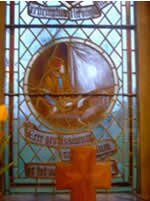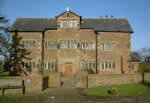Jeremiah Horrocks (1619 to 1641) and the Transit of Venus
On 24 November 1639 (Julian Calendar) in the tiny Lancashire village of Much Hoole, Jeremiah Horrocks made the first observations of a Transit of Venus. He was one of the first Englishmen to appreciate the astronomical revolution going on in Europe following the works of Tycho, Galileo and Kepler. It was Horrocks who first proved that the orbit of the moon is an ellipse, and Newton made good use of Horrocks’ discovery. Horrocks, who died at age 22, can be considered to be the father of British astrophysics for the remarkable depth of his accomplishments. His legacy reverberates today.
Transits of Venus were observed again in 1874 and 1882 for refinement of the value of the astronomical unit. No living person has ever seen this rare event. The next Transit of Venus will take place on the morning of Tuesday, 8 June 2004 beginning just after 05:19 UT (06:19 BST) and lasting for nearly 6 hours.
Jeremiah Horrocks, a farmer's son, was probably born in Toxteth, Liverpool in 1619. At the age of thirteen he entered Emmanuel College, Cambridge as a 'sizar' or poor scholar and taught himself Astronomy. In 1635 he returned to Toxteth and used Kepler's Laws of Planetary Motion to prove that the Moon orbited the earth elliptically.
Following Kepler's prediction that Venus would transit the Sun in 1631, Horrocks calculated that these transits occurred not singly but in pairs eight years apart.
On November 24th 1639, the date of the second transit Horrocks - now living in Much Hoole near Preston - had prepared his equipment for the observation. Using a simple telescope set on a wooden beam, he could project a solar image onto a piece of paper marked with a six inch graduated circle. He had observed on the day before he had calculated the transit would come, and had seen nothing. He then says:
“I watched carefully on the 24th from sunrise to nine o’clock, and from a little before ten until noon, and at one in the afternoon, being called away in the intervals by business of the highest importance which, for these ornamental pursuits, I could not with propriety neglect. But during all this time I saw nothing in the sun except a small and common spot… This evidently had nothing to do with Venus. About fifteen minutes past three in the afternoon, when I was again at liberty to continue my labours, the clouds, as if by divine interposition, were entirely dispersed, and I was once more invited to the grateful task of repeating my observations. I then beheld a most agreeable spectacle, the object of my sanguine wishes, a spot of unusual magnitude and of a perfectly circular shape, which had already fully centred upon the sun’s disc on the left, so that the limbs of the Sun and Venus precisely coincided, forming an angle of contact. Not doubting that this was really the shadow of the planet, I immediately applied myself sedulously to observe it.” [Jeremiah Horrocks On the Transit of Venus (Tr Whatton, 1859) p. 124.]
Horrocks had about thirty-five minutes to observe the transit before apparent sunset at 3.50 pm, making three careful measurements at 3.15, 3.35 and 3.45. Much Hoole residents may not be altogether flattered by Horrocks’s comment at this point that the observation was made in “an obscure village… about fifteen miles to the north of Liverpool.” Liverpool itself, of course, in those days, was not a centre of industry, but a place (as Whatton remarks) of “comparative insignificance”!
He was able to make three measurements and hence calculate for Venus its Transit path, angular size, and orbital velocity. He derived a value for the solar parallax, smaller than previously recorded, and so concluded that the Sun was further away from the Earth than thought. In 1640 he returned to Toxteth, wrote his "Venus in Sole Visa" and started working for his next treatise on solar dimensions. On January 3rd 1641 Jeremiah Horrocks died suddenly.
During the Victorian age Horrocks was eulogized with a plaque in Westminster Abbey and two stained glass windows in St.Michael's Church, Much Hoole.
|



